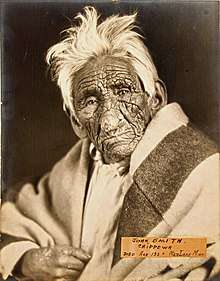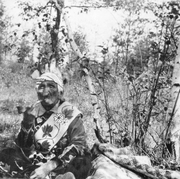John Smith (Chippewa Indian)
Chief John Smith (born between 1822 and 1826 (allegedly as early as 1784), died February 6, 1922), also known as Gaa-binagwiiyaas ("which the flesh peels off") — recorded variously as Kahbe nagwi wens, Ka-be-na-gwe-wes, Ka-be-nah-gwey-wence, Kay-bah-nung-we-way or Ga-Be-Nah-Gewn-Wonce — translated into English as "Sloughing Flesh", "Wrinkle Meat", or Old "Wrinkled Meat", was a Chippewa Native American who lived in the Cass Lake, Minnesota, area. In 1920, two years before his death, he appeared as the main feature in a motion picture exhibition which toured the United States, featuring old Native Americans.
(Chief) John Smith | |
|---|---|
 Chief John Smith c. 1915 | |
| Born | between 1822 and 1826 (allegedly as early as 1784) |
| Died | February 6, 1922 (aged 96-100) (claimed 137 years old) |
| Nationality | Chippewa native american |
| Other names | Chief John Smith,Kahbe nags wens, Ka-be-na-gwe-wes, Ka-be-nah-gwey-wence, Kay-bah-nung-we-way, Ga-Be-Nah-Gewn-Wonce |
| Citizenship | Cass Lake, Minnesota, United States |
| Known for | Longevity claimant, native american tribal chief |
Biography


Photo courtesy of the Minnesota Historical Society
Smith was a Chippewa Native American who lived in the Cass Lake, Minnesota, area and was reputed to have died at the age of 137. John Smith died of pneumonia, in Cass Lake, Minnesota. He was known as "The Old Indian" to the local white people.[1] He had eight wives and no children, except for an adopted son, named Tom Smith.
Local photographers, notably including C.N. Christensen of Cass Lake, used him as a model for numerous stylized images of Ojibwe life, which were widely distributed as cabinet photos and postcards. Smith would carry cartes de viste of himself, selling them to visitors. He was known to travel for free on the trains running through the Reservation, selling his photo to passengers, and becoming something of an attraction in and of himself.[2]
Smith converted to Catholicism in about 1914, and is buried in the Catholic section of Pine Grove Cemetery in Cass Lake.
The exact age of John Smith at the time of his death has been a subject of controversy. Federal Commissioner of Indian Enrollment Ransom J. Powell argued that "it was disease and not age that made him look the way he did"[2] and remarked that according to records he was only 88 years old. Paul Buffalo, who had met Smith when a small boy, said he had repeatedly heard the old man state that he was "seven or eight", "eight or nine" and "ten years old" when the "stars fell"[2] in the Leonid meteor shower of November 13, 1833, about which local historian Carl Zapffe writes: "Birthdates of Indians of the 19th Century had generally been determined by the Government in relation to the awe-inspiring shower of meteorites that burned through the American skies just before dawn on 13 November 1833, scaring the daylights out of civilized and uncivilized peoples alike. Obviously it was the end of the world. . . .".[3] This puts the oldest age of John Smith at just under 100 years at the time of his death.
Notes
- Star Tribune, February 8, 1922.
- Cited in Tim Roufs, When Everybody Called Me Gah-bay-bi-nayss: "Forever-Flying-Bird", footnote 34
- Zapffe C. The man who lived in 3 centuries (1975, p. 1) in Tim Roufs, When Everybody Called Me Gah-bay-bi-nayss: "Forever-Flying-Bird", footnote 35
Sources
- Timothy G. Roufs (2008). When Everybody Called Me Gah-bay-bi-nayss, "Forever-Flying-Bird": An Ethnographic Biography of Paul Peter Buffalo. University of Minnesota Duluth.
- "Obituary of Old John Smith in the Minneapolis Morning Tribune (Feb. 8, 1922)". Star Tribune. Archived from the original on 14 March 2008. Retrieved 19 April 2017.
Further reading
- Carl A. Zapffe, Kahbe nagwi wens: The man who lived in 3 centuries (Brainerd, MN: Historic Heartland Association, 1975) ISBN 978-0-910623-00-1
- John Smith Chief John Smith, A Leader of the Chippewa, Age 117 Years. His Life as Told by Himself. Being the Life Story of Chief John Smith as Narrated by Himself and Interpreted by His Adopted Son, Thomas E. Smith. (Walker, MN: The Cass County Pioneer, 1921)